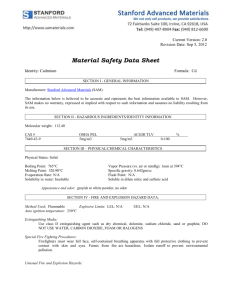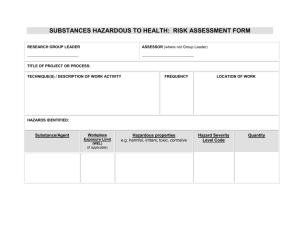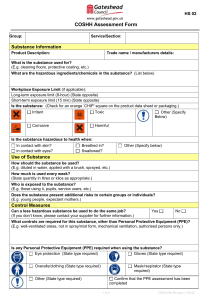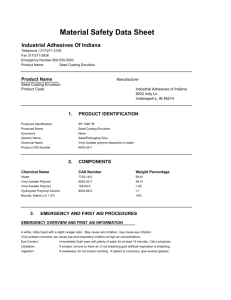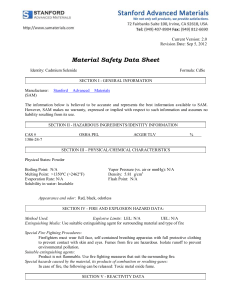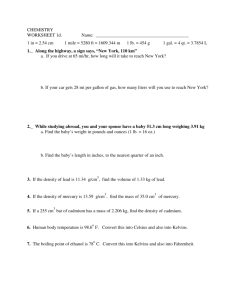Date: 10/22/08 Effective:
advertisement
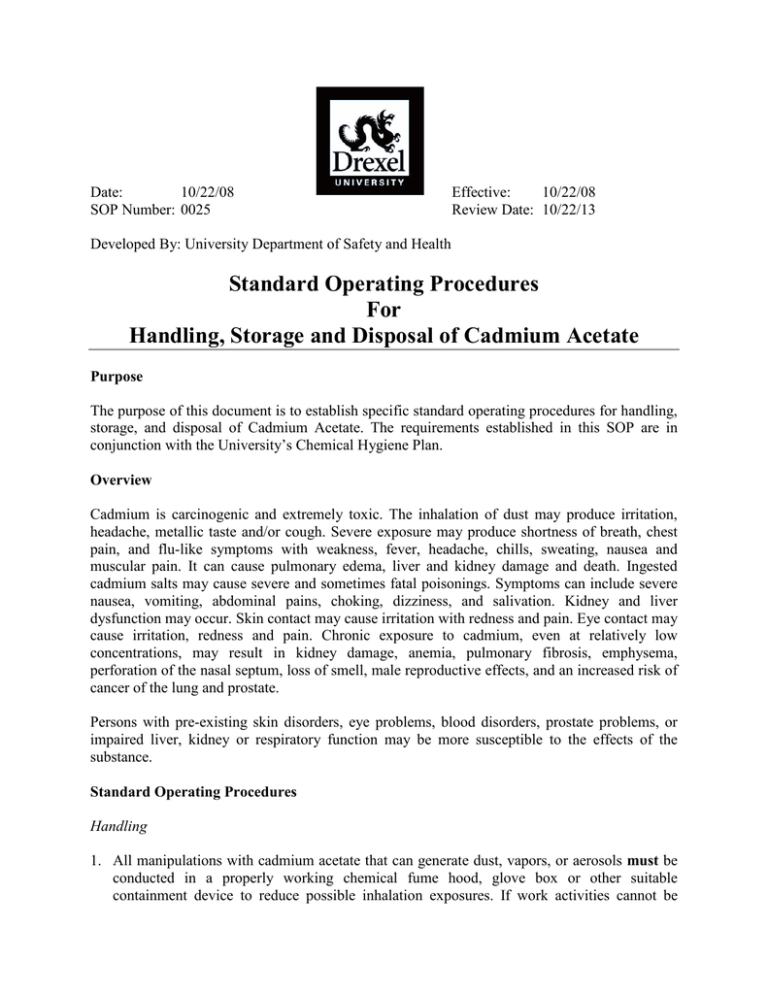
Date: 10/22/08 SOP Number: 0025 Effective: 10/22/08 Review Date: 10/22/13 Developed By: University Department of Safety and Health Standard Operating Procedures For Handling, Storage and Disposal of Cadmium Acetate Purpose The purpose of this document is to establish specific standard operating procedures for handling, storage, and disposal of Cadmium Acetate. The requirements established in this SOP are in conjunction with the University’s Chemical Hygiene Plan. Overview Cadmium is carcinogenic and extremely toxic. The inhalation of dust may produce irritation, headache, metallic taste and/or cough. Severe exposure may produce shortness of breath, chest pain, and flu-like symptoms with weakness, fever, headache, chills, sweating, nausea and muscular pain. It can cause pulmonary edema, liver and kidney damage and death. Ingested cadmium salts may cause severe and sometimes fatal poisonings. Symptoms can include severe nausea, vomiting, abdominal pains, choking, dizziness, and salivation. Kidney and liver dysfunction may occur. Skin contact may cause irritation with redness and pain. Eye contact may cause irritation, redness and pain. Chronic exposure to cadmium, even at relatively low concentrations, may result in kidney damage, anemia, pulmonary fibrosis, emphysema, perforation of the nasal septum, loss of smell, male reproductive effects, and an increased risk of cancer of the lung and prostate. Persons with pre-existing skin disorders, eye problems, blood disorders, prostate problems, or impaired liver, kidney or respiratory function may be more susceptible to the effects of the substance. Standard Operating Procedures Handling 1. All manipulations with cadmium acetate that can generate dust, vapors, or aerosols must be conducted in a properly working chemical fume hood, glove box or other suitable containment device to reduce possible inhalation exposures. If work activities cannot be 2. 3. 4. 5. 6. 7. 8. conducted under local exhaust ventilation then the PI must contact the Department of Environmental Health and Safety for consideration of respiratory protection. Proper personal protection equipment (PPE) must be worn at all times to prevent eye and skin contact. The minimum requirement for PPE is safety glasses with side shields, laboratory coat, and protective gloves. The suggested glove for working with this material is nitrile. Be sure to inspect all PPE prior to and after use. Designate an area in the laboratory chemical fume hood for only cadmium acetate manipulations. This area must be labeled with the appropriate hazard communication labels (i.e. carcinogen in use area). All equipment and PPE must remain in this designated area. Never remove contaminated equipment or PPE from designated area. Keep good housekeeping procedures. All disposable materials contaminated with cadmium acetate must be disposed as hazardous waste. The laboratory must be equipped with a working eyewash station and safety shower. Always practice good laboratory hygiene. Wash hands, face, neck and forearms frequently. Wash hands before eating and do not eat, drink, or smoke in the laboratory. Any amount of cadmium acetate spilled must be immediately reported as a major spill event. Storage 1. The cadmium acetate must be stored in a tightly closed secondary containment containers in the chemical fume hood. 2. Do not store this material with incompatible materials. Reacts with strong oxidizers, elemental sulfur, selenium, tellurium, strong acids, metals, hydrogen azide, zinc, and nitrates. 3. The storage area containing this material must be labeled with the appropriate hazard communication label (i.e. toxic or poison). 4. The secondary containment container must be labeled according to University guidelines (i.e. full chemical name; hazard warning words – toxic; carcinogen; responsible party). 5. Due to the hazardous nature of the material only minimal quantities of material should be purchased and stored. Disposal 1. All waste of cadmium acetate must be collected in a sealable compatible container (i.e. brown glass bottle) and disposed as hazardous waste as per University Hazardous Waste Guidelines. 2. All residual materials and rinse water from empty containers of this material must be collected and disposed as hazardous waste. 3. The rinse water from decontamination of all non-disposable equipment must be collected and disposed as hazardous waste. 4. All disposable materials contaminated with this material must be disposed as hazardous waste. 5. Drain disposal of any of these materials is strictly forbidden. 6. A chemical pick-up request form must be completed and submitted when the hazardous waste needs to be removed.
